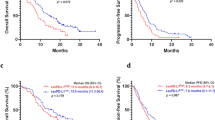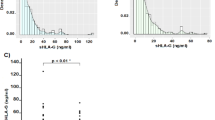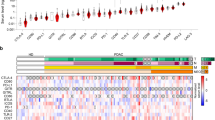Abstract
Regenerating gene family, member 4 (Reg IV), a secreted protein, is overexpressed in several cancers, including gastric cancer (GC). In the present study, we measured Reg IV levels in sera from patients with GC by enzyme-linked immunosorbent assay. We also examined the effect of forced Reg IV expression on the apoptotic susceptibility to 5-fluorouracil (5-FU). Forced expression of Reg IV inhibited 5-FU-induced apoptosis. Induction of Bcl-2 and dihydropyrimidine dehydrogenase was involved in inhibition of apoptosis. Among 36 GC patients treated with a combination chemotherapy of low-dose 5-FU and cisplatin, all 14 Reg IV-positive patients showed no change or disease progression. The serum Reg IV concentration was similar between healthy individuals (mean±s.e., 0.52±0.05 ng/ml) and patients with chronic-active gastritis (0.36±0.09 ng/ml). However, the serum Reg IV concentration in presurgical GC patients was significantly elevated (1.96±0.17 ng/ml), even at stage I. The diagnostic sensitivity of serum Reg IV (36.1%) was superior to that of serum carcinoembryonic antigen (11.5%) or carbohydrate antigen 19-9 (13.1%). These results indicate that expression of Reg IV is a marker for prediction of resistance to 5-FU-based chemotherapy in patients with GC. Serum Reg IV represents a novel biomarker for GC.
This is a preview of subscription content, access via your institution
Access options
Subscribe to this journal
Receive 50 print issues and online access
$259.00 per year
only $5.18 per issue
Buy this article
- Purchase on Springer Link
- Instant access to full article PDF
Prices may be subject to local taxes which are calculated during checkout



Similar content being viewed by others
References
Alley MC, Scudiero DA, Monks A, Hursey ML, Czerwinski MJ, Fine DL et al. (1988). Feasibility of drug screening with panels of human tumor cell lines using a microculture tetrazolium assay. Cancer Res 48: 589–601.
Ashkenazi A, Dixit VM . (1999). Apoptosis control by death and decoy receptors. Curr Opin Cell Biol 11: 255–260.
Aung PP, Oue N, Mitani Y, Nakayama H, Yoshida K, Noguchi T et al. (2006). Systematic search for gastric cancer-specific genes based on SAGE data: melanoma inhibitory activity and matrix metalloproteinase-10 are novel prognostic factors in patients with gastric cancer. Oncogene 25: 2546–2557.
Bishnupuri KS, Luo Q, Murmu N, Houchen CW, Anant S, Dieckgraefe BK . (2006). Reg IV activates the epidermal growth factor receptor/Akt/AP-1 signaling pathway in colon adenocarcinomas. Gastroenterology 130: 137–149.
Buckhaults P, Rago C, St Croix B, Romans KE, Saha S, Zhang L et al. (2001). Secreted and cell surface genes expressed in benign and malignant colorectal tumors. Cancer Res 61: 6996–7001.
Green DR, Reed JC . (1998). Mitochondria and apoptosis. Science 281: 1309–1312.
Hanahan D, Weinberg RA . (2000). The hallmarks of cancer. Cell 100: 57–70.
Harris BE, Song R, Soong SJ, Diasio RB . (1990). Relationship between dihydropyrimidine dehydrogenase activity and plasma 5-fluorouracil levels with evidence for circadian variation of enzyme activity and plasma drug levels in cancer patients receiving 5-fluorouracil by protracted continuous infusion. Cancer Res 50: 197–201.
Hartupee JC, Zhang H, Bonaldo MF, Soares MB, Dieckgraefe BK . (2001). Isolation and characterization of a cDNA encoding a novel member of the human regenerating protein family: Reg IV. Biochim Biophys Acta 1518: 287–293.
Hohenberger P, Gretschel S . (2003). Gastric cancer. Lancet 362: 305–315.
Inada T, Ogata Y, Kubota T, Tomikawa M, Yamamoto S, Andoh J et al. (2000). 5-Fluorouracil sensitivity and dihydropyrimidine dehydrogenase activity in advanced gastric cancer. Anticancer Res 20: 2457–2462.
Ishikawa Y, Kubota T, Otani Y, Watanabe M, Teramoto T, Kumai K et al. (2000). Dihydropyrimidine dehydrogenase and messenger RNA levels in gastric cancer: possible predictor for sensitivity to 5-fluorouracil. Jpn J Cancer Res 91: 105–112.
Kari C, Chan TO, Rocha de Quadros M, Rodeck U . (2003). Targeting the epidermal growth factor receptor in cancer: apoptosis takes center stage. Cancer Res 63: 1–5.
Kaufmann SH, Desnoyers S, Ottaviano Y, Davidson NE, Poirier GG . (1993). Specific proteolytic cleavage of poly(ADP-ribose) polymerase: an early marker of chemotherapy-induced apoptosis. Cancer Res 53: 3976–3985.
Kim R, Murakami S, Ohi Y, Inoue H, Yoshida K, Toge T . (1999). A phase II trial of low dose administration of 5-fluorouracil and cisplatin in patients with advanced and recurrent gastric cancer. Int J Oncol 15: 921–926.
Kochi M, Fujii M, Kanamori N, Kaiga T, Kawakami T, Aizaki K et al. (2000). Evaluation of serum CEA and CA19–9 levels as prognostic factors in patients with gastric cancer. Gastric Cancer 3: 177–186.
Kuramochi H, Hayashi K, Uchida K, Miyakura S, Shimizu D, Vallbohmer D et al. (2006). 5-Fluorouracil-related gene expression levels in primary colorectal cancer and corresponding liver metastasis. Int J Cancer 119: 522–526.
Li P, Nijhawan D, Budihardjo I, Srinivasula SM, Ahmad M, Alnemri ES et al. (1997). Cytochrome c and dATP-dependent formation of Apaf-1/caspase-9 complex initiates an apoptotic protease cascade. Cell 91: 479–489.
Longley DB, Harkin DP, Johnston PG . (2003). 5-Fluorouracil: mechanisms of action and clinical strategies. Nat Rev Cancer 3: 330–338.
Mantel N . (1966). Evaluation of survival data and two new rank order statistics arising in its consideration. Cancer Chemother Rep 50: 163–170.
Martinou JC, Desagher S, Antonsson B . (2000). Cytochrome c release from mitochondria: all or nothing. Nat Cell Biol 2: E41–43.
Ochiai A, Yasui W, Tahara E . (1985). Growth-promoting effect of gastrin on human gastric carcinoma cell line TMK-1. Jpn J Cancer Res 76: 1064–1071.
Oue N, Hamai Y, Mitani Y, Matsumura S, Oshimo Y, Aung PP et al. (2004). Gene expression profile of gastric carcinoma: identification of genes and tags potentially involved in invasion, metastasis and carcinogenesis by serial analysis of gene expression. Cancer Res 64: 2397–2405.
Oue N, Mitani Y, Aung PP, Sakakura C, Takeshima Y, Kaneko M et al. (2005). Expression and localization of Reg IV in human neoplastic and non-neoplastic tissues: Reg IV expression is associated with intestinal and neuroendocrine differentiation in gastric adenocarcinoma. J Pathol 207: 185–198.
Sobin LH, Wittekind CH (eds). (2002). TNM Classification of Malignant Tumors 6th edn. Wiley-Liss Inc: New York, pp 65–68.
Tahara Jr E, Tahara H, Kanno M, Naka K, Takeda Y, Matsuzaki T et al. (2005). G1P3, an interferon inducible gene 6–16, is expressed in gastric cancers and inhibits mitochondrial-mediated apoptosis in gastric cancer cell line TMK-1 cell. Cancer Immunol Immunother 54: 729–740.
Takebe N, Zhao SC, Ural AU, Johnson MR, Banerjee D, Diasio RB et al. (2001). Retroviral transduction of human dihydropyrimidine dehydrogenase cDNA confers resistance to 5-fluorouracil in murine hematopoietic progenitor cells and human CD34+-enriched peripheral blood progenitor cells. Cancer Gene Ther 8: 966–973.
Ukon K, Tanimoto K, Shimokuni T, Noguchi T, Hiyama K, Tsujimoto H et al. (2005). Activator protein accelerates dihydropyrimidine dehydrogenase gene transcription in cancer cells. Cancer Res 65: 1055–1062.
Vander Heiden MG, Thompson CB . (1999). Bcl-2 proteins: regulators of apoptosis or of mitochondrial homeostasis? Nat Cell Biol 1: E209–216.
Violette S, Festor E, Pandrea-Vasile I, Mitchell V, Adida C, Dussaulx E et al. (2003). Reg IV, a new member of the regenerating gene family, is overexpressed in colorectal carcinomas. Int J Cancer 103: 185–193.
Yasui W, Ayhan A, Kitadai Y, Nishimura K, Yokozaki H, Ito H et al. (1993). Increased expression of p34cdc2 and its kinase activity in human gastric and colonic carcinomas. Int J Cancer 53: 36–41.
Yasui W, Oue N, Ito R, Kuraoka K, Nakayama H . (2004). Search for new biomarkers of gastric cancer through serial analysis of gene expression and its clinical implications. Cancer Sci 95: 385–392.
Yasui W, Sumiyoshi H, Hata J, Kameda T, Ochiai A, Ito H et al. (1988). Expression of epidermal growth factor receptor in human gastric and colonic carcinomas. Cancer Res 48: 137–141.
Acknowledgements
We thank M Takatani and M Ikeda for excellent technical assistance and advice. This work was carried out with the kind cooperation of the Research Center for Molecular Medicine, Faculty of Medicine, Hiroshima University. We thank the Analysis Center of Life Science, Hiroshima University for the use of their facilities. This work was supported, in part, by Grants-in-Aid for Cancer Research from the Ministry of Education, Culture, Science, Sports and Technology of Japan, and from the Ministry of Health, Labor and Welfare of Japan.
Author information
Authors and Affiliations
Corresponding author
Rights and permissions
About this article
Cite this article
Mitani, Y., Oue, N., Matsumura, S. et al. Reg IV is a serum biomarker for gastric cancer patients and predicts response to 5-fluorouracil-based chemotherapy. Oncogene 26, 4383–4393 (2007). https://doi.org/10.1038/sj.onc.1210215
Received:
Revised:
Accepted:
Published:
Issue Date:
DOI: https://doi.org/10.1038/sj.onc.1210215



